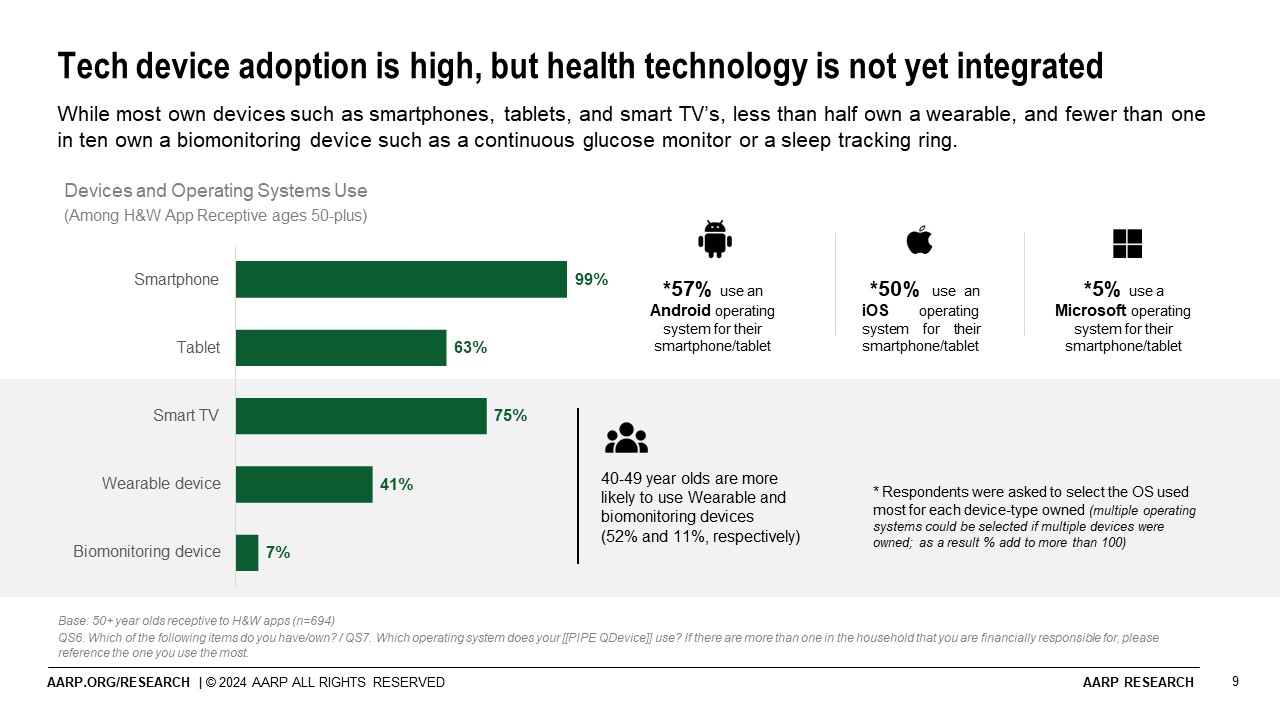AARP fielded a survey that is worth a look. The topic was health and wellness app usage by the 50+ population. The goal was to understand 50+ level of engagement with health and wellness apps – an online survey that included 694 individuals who owned smartphone or tablet. Interestingly the 15-minutes survey also includes a response comparison with 40-49 year-olds, likely because that is AARP’s next-up target membership. Responders needed to be comfortable with downloading a health and wellness app — and have interest in trying them.
Fitness apps have won among the 50+. It should not come as a surprise that the most popular app category was fitness and exercise tracking (55{e60f258f32f4d0090826105a8a8e4487cca35cebb3251bd7e4de0ff6f7e40497}). Oddly, the report notes that there are 350,000 health and wellness apps available, and noted multiple categories – but it made no specific mention of them – and the survey showed that other than fitness, utilization was low. Among mentions, Samsung and Apple Health had notable usage of these pre-installed health apps. Most app users are willing to download other apps beyond those that are pre-installed. As with other surveys of consumers, when asked about familiarity with AI, the responses are predictable – 75{e60f258f32f4d0090826105a8a8e4487cca35cebb3251bd7e4de0ff6f7e40497} are familiar, 91{e60f258f32f4d0090826105a8a8e4487cca35cebb3251bd7e4de0ff6f7e40497} are concerned about AI privacy and accuracy.
Barriers are predictable – cost leads — ironically. Asked generally about preference, responders prefer health and wellness apps to be free, though interestingly although cost was cited as a barrier to usage,16{e60f258f32f4d0090826105a8a8e4487cca35cebb3251bd7e4de0ff6f7e40497} were willing to pay for AI-generation of a personalized plan. Also interesting was the equal split of responders into Android and iOS, though Apple currently has greater market share in the US – 56{e60f258f32f4d0090826105a8a8e4487cca35cebb3251bd7e4de0ff6f7e40497} to 43{e60f258f32f4d0090826105a8a8e4487cca35cebb3251bd7e4de0ff6f7e40497}. It is perplexing, though, that these responders have paid for an iOS smartphone ranging from $800 to $1500 or an Android from $600 to $1300 but can’t afford the Apple Fitness+ app for $9.99/month.
Those with chronic conditions don’t see that apps help with improved outcomes – really? It would be intriguing to probe further among the 63{e60f258f32f4d0090826105a8a8e4487cca35cebb3251bd7e4de0ff6f7e40497} that indicated they have a chronic condition or the 73{e60f258f32f4d0090826105a8a8e4487cca35cebb3251bd7e4de0ff6f7e40497} that experience physical limitations around, for example, movement, hearing, vision, or mobility. The report indicates these users have not connected use of the technology with better health outcomes. Really? Ask individuals, especially the 50+, with those specific limitations. Ask them about tech designed for them. And note the multitude of websites that identify and categorize the tools – low vision, mobility, hearing loss, or diabetes management.
The report notes that health technology is not integrated – though it is unclear what that means. The implication is across smartphones, tablets, smart TV’s and wearables – though that is not the only lens, and an unlikely one for any type of integration. As health status changes over time, people have different needs. It’s daunting to think of shopping all over again to accommodate that next stage – and a whole new set of players in the market. In the future, app providers and those who serve them, like AARP, who provide guidance to consumers, will begin to envision a market of suites that can help manage the evolution of change experienced by all older adults. Suites for older adults will be comprised of apps that complement each other, but do not have to be integrated with each other. Tech firms and organizations like AARP will begin to envision those quality of life benefits, and begin to think holistically about health and wellness needs over time. And the consumers will learn to expect these suites, and for the best ones, pay for them.




